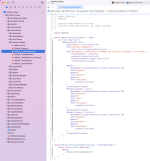Nycturne
Elite Member
- Joined
- Nov 12, 2021
- Posts
- 1,681
Since a couple of us keep getting sidetracked discussing development in Swift or on Apple platforms, maybe we can do some of it here? A place to post questions, neat learnings, complaints, etc to share with others without sidetracking other threads on it?
Maybe I can start by saying: SwiftUI, you are drunk, go home. When you attach a context menu to a view, if it happens to be a button (NavigationLink in this case), it replicates the button's state at the time instead of rendering the button content. But if I attach the context view to the content, the button can swallow the gesture and prevent the context menu from working unless you are on macOS. Great times. Great times. I suspect I'm going to have to drop down to UIKit to get behavior I like on this one.

Maybe I can start by saying: SwiftUI, you are drunk, go home. When you attach a context menu to a view, if it happens to be a button (NavigationLink in this case), it replicates the button's state at the time instead of rendering the button content. But if I attach the context view to the content, the button can swallow the gesture and prevent the context menu from working unless you are on macOS. Great times. Great times. I suspect I'm going to have to drop down to UIKit to get behavior I like on this one.

